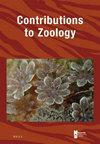Morphological and genetic diversification of Old-World marbled newts, with the description of a new and ‘not-at-all-cryptic’ subspecies from the Iberian Peninsula (Triturus, Salamandridae)
IF 2.2
2区 生物学
Q1 ZOOLOGY
引用次数: 0
Abstract
Morphological and genetic variation of organisms is generally lower in northern than in southern regions of the Palearctic. This ubiquitous geographical pattern has been associated with extinction and recolonization processes in the north versus persistence in the Mediterranean area, as governed by climate change in the Pleistocene. One area of differentiation and complexity is the Iberian Peninsula where two distinct sister-species of marbled newts possess adjoining and geographically sharply delimited ranges over the north (Triturus marmoratus) and the south of the peninsula (T. pygmaeus). Within the latter species two forms are here documented, with different colouration patterns and non-overlapping ranges. The southern form is striped, much as in T. marmoratus, and occurs to the south of the Guadalquivir River. The northern form, here described as a new subspecies, has a reticulated dorsal colouration. It occurs only north of the Guadalquivir and is thus sandwiched in between two striped marbled newt taxa. Both T. pygmaeus subspecies engage inside the Doñana National Park in a ca. 2,500 m narrow contact zone. Although an inferred substantial selection against hybrids goes a long way to support species status, a reanalysis of published genetic data is required to solve this issue, along with the wider investigation of the same type of (microsatelite) data for the southern, nominotypical subspecies.旧大陆大理石纹蝾螈的形态和遗传多样性,并描述了来自伊比利亚半岛的一个新的、"一点也不神秘 "的亚种(Triturus,Salamandridae)
古北区北部生物的形态和遗传变异普遍低于南部地区。这种无处不在的地理模式与北方的灭绝和重新定居过程有关,而地中海地区的持续存在则受更新世气候变化的影响。伊比利亚半岛是一个分化和复杂的地区,那里有两个不同的大理石纹蝾螈姊妹种,它们在半岛北部(Triturus marmoratus)和南部(T. pygmaeus)的分布范围相邻,地理上界限分明。后者有两种形态,具有不同的色彩模式,分布范围也不重叠。南部的蟒蛇有条纹,与 T. marmoratus 相似,分布在瓜达尔基维尔河以南。北部形态在此被描述为一个新的亚种,背部呈网状。它只出现在瓜达尔基维尔河以北,因此被夹在两个条纹蝾螈类群之间。两个 T. pygmaeus 亚种都在多纳纳国家公园内约 2500 米的狭窄接触区内活动。尽管对杂交种的大量选择推断在很大程度上支持了物种地位,但要解决这个问题,还需要对已发表的遗传数据进行重新分析,同时对南部的提名亚种的同类(微卫星)数据进行更广泛的调查。
本文章由计算机程序翻译,如有差异,请以英文原文为准。
求助全文
约1分钟内获得全文
求助全文
来源期刊

Contributions to Zoology
生物-动物学
CiteScore
4.00
自引率
4.50%
发文量
16
审稿时长
>12 weeks
期刊介绍:
Contributions to Zoology solicits high-quality papers in all systematics-related branches of comparative zoology (including paleozoology). Preference will be given to manuscripts dealing with conceptual issues and to integrative papers (e.g., ecology and biodiversity, morphology and phylogeny and character state evolution, phylogeny and historical biogeography, systematics and bioinformatics, bioinformatics and biodiversity, habitat disturbance and biogeography, etc.). Reviews and alpha-taxonomic contributions are considered for publication, but acceptance will depend on their high quality and exceptional nature.
 求助内容:
求助内容: 应助结果提醒方式:
应助结果提醒方式:


